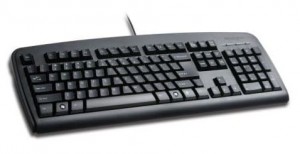If you’re looking for a new keyboard, you may be a bit overwhelmed by the variety of models, including those labeled “ergonomic.” Unfortunately, there is no governing body that determines whether or not something is ergonomic. To help alleviate the confusion, look for these features in your next keyboard.
- Keyboard slope – When keying, your hands should be in the neutral “hand shake” position (with your thumb slightly pointed up). There are many keyboards with varying degrees of slope, from just a slight bump to a full 90 degrees (imagine typing with your palms facing each other!). Many people prefer something in between, such as the Microsoft Natural Keyboard or the Logitech Wave. For an extreme slope, try the Kinesis Freestyle or the Goldtouch Adjustable.
- Key angle – The keys of a standard keyboard are aligned perpendicular to your body and can cause poor wrist posture. To reduce this, consider purchasing a keyboard with keys slightly angled inward, like the Kensington Comfort Type.
- Keystroke force – Fortunately, unless you have a keyboard with sticky keys, modern keyboards do not require excessive force to function. The variations in keystroke force enable people to choose their preference. Some prefer the “soft touch” keys similar to a laptop (I like the Microsoft Comfort Curve), while others like those that require more force due to the positive tactile feedback. Check out the Goldtouch Adjustable for a more traditional keystroke feel.
Because there is usually a learning curve with new equipment, try it before you buy it. Ask your company if they have an equipment trial program or be aware of the return policy. Regardless of which keyboard you choose, make sure it promotes neutral postures and is comfortable to use.
Photo: Kensington Comfort Type
